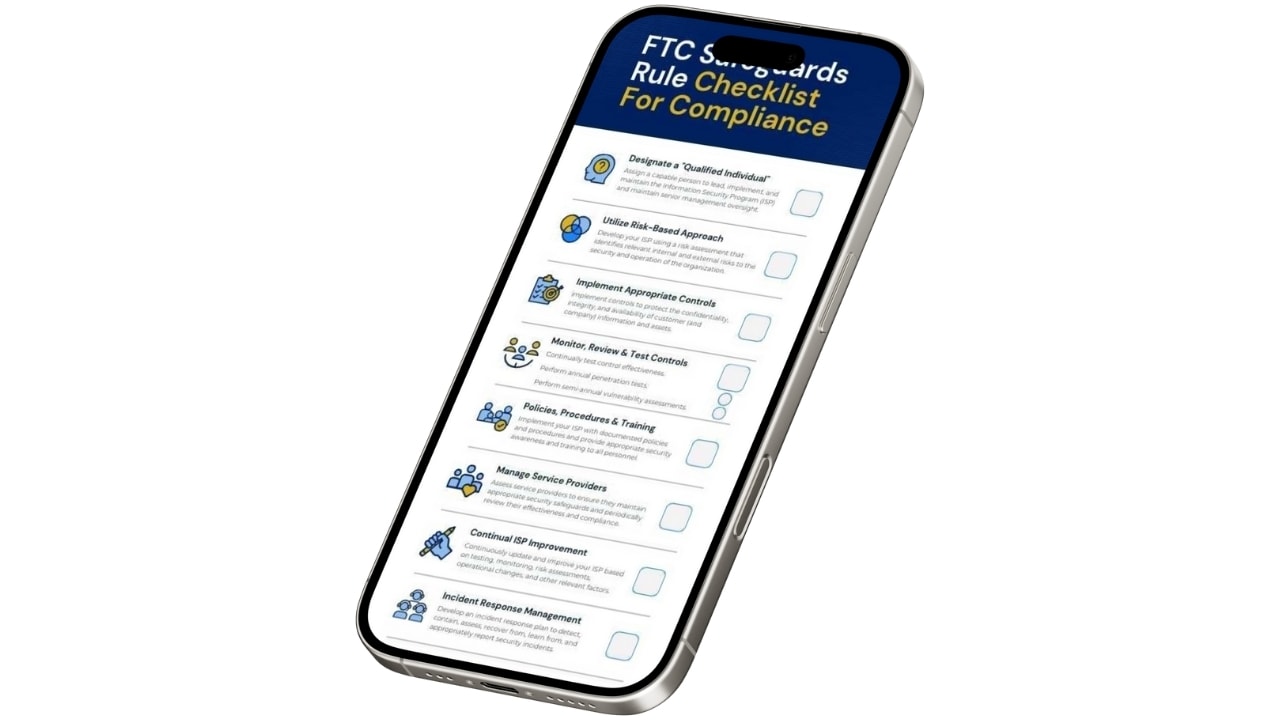FTC Safeguards Rule Checklist: Implementing Appropriate Controls with a Risk-Based Approach
Mar 20, 2025
Protecting customer financial data isn’t just good practice—it’s mandated by the FTC Safeguards Rule. Established under the Gramm-Leach-Bliley Act (GLBA), the rule mandates that financial institutions implement a comprehensive Information Security Program (ISP) to protect customer data. Originally enacted in 2003 and significantly updated effective June 9, 2023, these amendments emphasize implementing robust, risk-based safeguards that adapt dynamically to evolving threats.
In this article, we’ll take a detailed look at the FTC Safeguards Rule requirements under 16 CFR § 314.4(c), highlighting how your organization can effectively implement appropriate controls using a risk-based approach.
What is the FTC Safeguards Rule?
The Federal Trade Commission (FTC) Safeguards Rule establishes mandatory cybersecurity practices to protect customer financial information. Created under the Gramm-Leach-Bliley Act (GLBA), the rule initially launched in 2003, with significant amendments implemented as of June 2023. These changes emphasize thorough risk assessments, regular monitoring, service provider oversight, and proactive measures to protect against unauthorized access or data breaches.
The rule protects personally identifiable financial information, which falls under the category of nonpublic personal information and requires stringent protection.
The rule applies widely across industries that handle consumer financial information, such as tax preparation, auto financing, debt collection, and investment advising, among others. Ensuring compliance is not only necessary for avoiding penalties but also essential for maintaining customer trust and safeguarding your organization’s reputation.
Who Are Covered "Financial Institutions" Under the FTC Safeguards Rule?
The FTC defines “financial institutions” broadly, encompassing more than traditional banks. Many organizations that don't traditionally identify as financial institutions may still need to comply based on their business practices.
Common covered entities include:
-
Tax preparers and accountants
-
Mortgage brokers and lenders
-
Auto dealerships offering financing
-
Payday lenders
-
Credit counselors and debt collectors
-
Investment advisors (not regulated by the SEC)
-
Personal property appraisers
If your business handles sensitive customer financial data, you’re likely required to comply with the FTC Safeguards Rule. Beyond compliance, it's crucial to regularly assess your service providers to confirm they maintain strong security practices.
For more guidance on determining if your business must comply, see our full guide on FTC Safeguards Rule Requirements.
FTC Safeguards Rule Checklist – Key Requirements

The FTC Safeguards Rule checklist provides a structured framework for compliance, requiring organizations to:
-
Designate a “Qualified Individual” to oversee information security (16 CFR § 314.4(a))
-
Develop and maintain a comprehensive ISP using a risk-based approach (16 CFR § 314.4(b))
-
Implement safeguards to protect customer information, data integrity and ensure compliance with regulations (16 CFR § 314.4(c))
-
Regularly monitor, review, and test implemented security measures (16 CFR § 314.4(d))
-
Establish clear policies, procedures, and security training programs (16 CFR § 314.4(e))
-
Manage and oversee service provider compliance (16 CFR § 314.4(f))
-
Continuously improve the ISP based on monitoring outcomes (16 CFR § 314.4(g))
-
Prepare an incident response plan to handle security events effectively (16 CFR § 314.4(h))
-
Adhere to breach notification requirements
-
Provide regular written security reports to your board or senior leadership (16 CFR § 314.4(i))
In this article, we are specifically exploring Step 3: Implementing appropriate security controls to mitigate identified risks.
Detailed Review of Required Controls:
1. Access Controls (16 CFR § 314.4(c)(1))
Effective access management is critical for every cybersecurity program and protecting customer data from both internal and external threats.
Proper access management ensures that only authorized individuals have access to sensitive data, mitigating internal threats and accidental exposure. Implement strong authentication procedures, including robust passwords and biometric or token-based systems. Additionally, implement multi factor authentication as part of compliance with the Federal Trade Commission's updated Safeguards Rule to enhance data security measures. Consistently verify the identities of users accessing sensitive systems to prevent unauthorized access.
Adopt the principle of least privilege, granting employees access only to the information they need to perform their duties. Regularly review access rights and adjust privileges promptly when roles or personnel change. Physical security controls—like secure facility entry systems—should complement technical safeguards, providing comprehensive protection against unauthorized physical access.
Conduct periodic audits of access controls to verify effectiveness. Adjust your strategies as the business environment and potential threats evolve, and document these evaluations as part of your ongoing compliance efforts.
2. Identify and Manage Assets (16 CFR § 314.4(c)(2))

Comprehensive asset management forms the backbone of an effective information security program. Clearly identify critical assets, including data, hardware, software, facilities, and personnel crucial to your business operations.
Regularly perform risk assessments to gauge the value and vulnerability of these assets, categorizing them according to their importance and sensitivity. Develop and maintain an accurate inventory, regularly updating it to reflect business changes or shifts in priorities.
Establish a risk-based classification strategy to prioritize assets requiring stronger protections. Align your security resources to focus on the assets most critical to your business objectives, streamlining your approach to risk mitigation.
3. Data Encryption and Alternative Controls (16 CFR § 314.4(c)(3))
Encryption remains a fundamental control for securing customer information. Prioritize encryption of sensitive data in transit across external networks and while at rest in storage systems. Select encryption standards that align with industry best practices, using strong cryptographic algorithms to safeguard data integrity and confidentiality. The risks associated with unencrypted customer information are significant, as unauthorized acquisition of such data can lead to severe consequences, including the need to notify the FTC if it affects at least 500 consumers.
In cases where encryption proves technically infeasible, document your reasoning and seek approval from your Qualified Individual. Implement alternative compensating controls, such as enhanced access restrictions, robust physical security measures, and regular, intensive monitoring of data access and use.
Clearly document and periodically revisit these compensating controls to ensure they continue to provide equivalent security compared to encryption.
4. Secure Development Practices (16 CFR § 314.4(c)(4))

Integrating security into your application development lifecycle significantly reduces vulnerabilities and protects customer data. Establish secure coding standards, including best practices such as OWASP guidelines, to minimize common vulnerabilities.
Conduct regular code reviews and security assessments for both in-house developed and externally procured applications. Employ rigorous testing procedures, such as penetration testing and vulnerability assessments, to identify potential weaknesses before deployment.
Maintain comprehensive documentation of your development lifecycle and actively audit this documentation to ensure continuous adherence to security standards.
5. Multifactor Authentication (16 CFR § 314.4(c)(5))
Multifactor Authentication (MFA) significantly reduces the risk of unauthorized access by requiring multiple verification methods. Implement MFA across all systems handling sensitive customer data, ensuring that additional security layers are present to protect data integrity.
If MFA implementation faces technical or operational constraints, document your reasons clearly and obtain explicit, written approval from your Qualified Individual for any alternative security measures.
Regularly revisit your MFA implementation strategy, adjusting to changes in the threat landscape or emerging security technologies.
6. Data Retention and Disposal Policies (16 CFR § 314.4(c)(6))
Effective data retention and disposal policies mitigate risks associated with unnecessary data exposure. Establish clear procedures for securely disposing of customer information within two years of its last active use, unless regulatory requirements dictate longer retention.
Utilize secure disposal methods such as shredding physical documents, securely wiping digital media, and destroying storage hardware containing sensitive data.
Consistently review your retention policies, identifying opportunities to minimize data storage and thereby reducing the potential for breaches or unauthorized data disclosures.
7. Change Management Procedures (16 CFR § 314.4(c)(7))
Managing system changes securely is critical to maintaining a secure environment. Establish a clear, documented change management process involving authorization, testing, and documentation.
Evaluate the security implications of any change prior to implementation, mitigating risks through appropriate testing and validation procedures. Incorporate security assessments into each phase of your change management process, ensuring that potential vulnerabilities are proactively addressed.
Document all changes meticulously, including approvals, implementation steps, and rollback plans. This documentation supports accountability and aids compliance during audits or assessments.
8. Monitoring and Activity Logging (16 CFR § 314.4(c)(8))

Continuous monitoring and detailed logging of activities are essential components of effective cybersecurity management. Implement comprehensive logging systems that capture detailed records of user actions, system access attempts, and data transactions.
Regularly review logs for unusual activity or anomalies indicative of potential unauthorized access or tampering. Integrate automated detection tools to facilitate real-time identification and rapid response to security incidents.
Ensure your organization has clearly defined incident response procedures, enabling rapid response to detected threats and procedures for reporting security events to potentially affected individuals and regulatory agencies. The FTC Safeguards Rule requires financial institutions to perform periodic testing of these procedures to ensure readiness and efficiency in actual incidents.
FTC Safeguards Rule Checklist for Compliance

This article is part of our FTC Safeguards Rule Compliance Checklist series. Don’t miss our FTC Safeguards Rule Compliance Infographic for a visual summary of all key requirements.
Simplifying Compliance with the Input Output WISP
Implementing a robust Information Security Program can seem daunting, especially for smaller businesses without dedicated cybersecurity staff. Designating a Qualified Individual, drafting comprehensive policies, procedures, and ensuring complete compliance with the FTC Safeguards Rule can significantly divert valuable resources from your core operations.
The Input Output Written Information Security Program (WISP) simplifies this process by offering businesses:
-
✅ Ready-to-use policies, procedures, and forms, eliminating the need to develop materials from scratch.
-
✅ Convenient templates that simplify designating and defining roles for your Qualified Individual.
-
✅ A comprehensive, pre-written Incident Response Plan, ensuring you meet compliance and preparedness requirements.
-
✅ Clear, step-by-step guidance to confidently meet all FTC Safeguards Rule requirements.
With Input Output’s WISP, your business can streamline compliance efforts, minimize regulatory risks, and return focus to your primary business activities. Simplify your path to compliance today with the Input Output WISP.
Conclusion
Compliance with the FTC Safeguards Rule involves ongoing vigilance to appropriately implement safeguards to protect sensitive customer information. Regularly revisiting your controls, adapting to evolving risks, and proactively strengthening your safeguards will help protect sensitive consumer information, preserve your organization's reputation, and enhance overall resilience.
STAY INFORMED
Subscribe now to receive the latest expert insights on cybersecurity, compliance, and business management delivered straight to your inbox.
We hate SPAM. We will never sell your information, for any reason.


